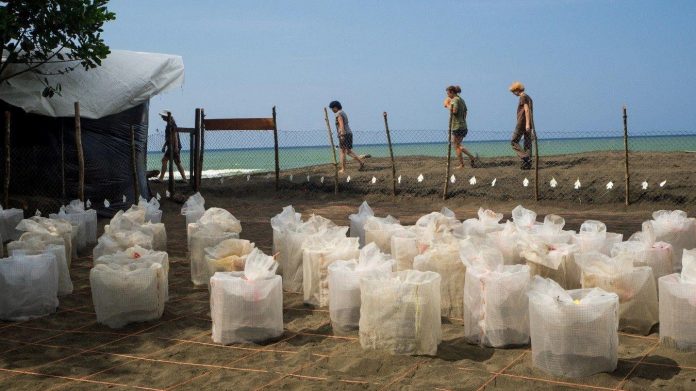Our new series “A Day in the Life” is part of our joint storytelling efforts with the members of Directory 506, our national directory of rural tourism. Directory 506 is being piloted with affiliates of the Rural and Community Tourism Chamber,and non-profit organizations affiliated with Amigos of Costa Rica..
We are proud that during our April edition, “The Trailblazers,” our Travel Thursdays will be created by rural tourism entrepreneurs and nonprofits around the country. To kick us off, we asked the leaders of the Latin American Sea Turtles (L.A.S.T) Association to tell us what it’s like to conduct night patrols to protect turtles and their eggs. Field biologist Eduardo Altamirano answered our questions about the patrols. Excerpts from his responses follow.

Sea turtles, like every living being on the planet, play a very important ecological role—particularly when it comes to marine ecosystems, so vulnerable and unknown. They keep other species under control and are therefore purifiers of the marine ecosystem. By feeding on jellyfish, cleaning corals, and controlling seagrass overgrowth, sea turtles ensure adequate growth and development of other species such as fish and crustaceans. In addition, the movement of sand during the nesting process and the decomposition of their eggs on the beach contributes an incredible amount of oxygen and nutrients to the sand. This is essential for the growth of microorganisms on the beach.
Barra Norte de Pacuare is a remote area of the Caribbean of Costa Rica, surrounded by exuberant fauna, vegetation and canals. The beach features many coconuts and is visited by three species of sea turtles that are currently in danger of extinction: the leatherback, green and hawksbill turtles. These turtles come to nest on this beach between February and November.

This part of Costa Rica is not a community as such: there are few people living near the beach. It stretches for 7.1 kilometers, bordered by Laguna de Perla to the north and the mouth of the Pacuare River to the south. It’s a beach of loose black sand with a changing profile due to constant erosion. At this site during our patrols, all you can hear is the sound of waves, birds and nocturnal insects that make the experience even more wild.
Barra Norte suffers from a high rate of poaching and hunting of turtles during the nesting season. The only way to counteract this is by protecting the turtles when they spawn and relocating their eggs to safe places such as nurseries, where we take care of them day and night until the young are born and go to sea.
The Latin American Sea Turtles Association (LAST) organizes this activity under the leadership of various people who work for the project. Some of these are local people, most of whom were illegal extractors of turtle eggs but now work to protect them. They belong to our local partner, partner the New Pacuare Environmental Association. Other participants are people from various countries who come to work as Research Assistants at LAST, as well as a large number of national and international visitors who participate as volunteers in our various conservation activities. These volunteers are recruited by LAST. The remoteness of the location sometimes lends itself to criminal activity. Therefore, we also work in coordination with the police and Coast Guard to guarantee everyone’s safety.

Sea turtles are species that nest at night, so our tours are nocturnal. Their activities are highly influenced by the tides, so each night’s schedule varies. In general, the earliest starting time for our trips is 8 pm.
To get to the LAST station in Pacuare, where all participants stay and the staging ground for the patrol, a half-hour boat ride is required through the canals from Goshen, Limón. At the station, we carry out a training on sea turtle monitoring techniques. The presentation includes aspects of biology and ecology, how we conduct patrols, and all the data we collect, as well as the work we do in the hatchery with sea turtle eggs and hatchlings.
The schedule and scope of the night’s work are assigned along with the groups that will participate in the patrol; a local or international participant is assigned as the leader.
When the time of the patrol arrives, the groups head out to their assigned sector, following a route of 10 km at the most per shift. They walk in the dark, following the leader’s directions and using red light only when necessary.

Finally, we come to the main event: spawning and egg collection. When we find a turtle, we have to wait patiently until the moment comes when we can collect its eggs, which will later be protected in our nursery. This moment is crucial, the most important and delicate of the night. We must remain silent and behind the turtle so as not to disturb or interrupt the process.
The feeling of finding a sea turtle on the beach is indescribable, especially if you have had a long night of walking, rain, and mosquitoes, and the group is full of the sensation that you might return to the station without success. All of a sudden, everything changes.
Spawning is a process that can last up two hours. A feeling of impatience dominates every moment, but you must be patient. The leader of the patrol supervises what the turtle is doing until it is safe for more people to approach. When spawning begins and the eggs begin to fall into the hole that the turtle has prepared, wonder and happiness take over. It is something that will remain with us for the rest of our lives. Turtles are so fragile and tough at the same time.
After 10 to 15 minutes, the team is responsible for safeguarding about 100 eggs. They must be carefully moved to the nursery, where someone will bury them, trying to replicate the size of the nest made by the turtle where it spawned.

ut before leaving with the eggs, we must record data and the turtle’s measurements, identify the individual by means of markings, and, in for green or hawksbill species, wait until they return to the sea so that they are not killed. Once all this is done, it is time to take the eggs to the nursery. There, they will remain in incubation for almost two months. At this location, volunteers and members of the association are in charge of taking care of the nursery at different times, avoiding looting or predation.
There is no defined end time for our night patrols, as each one can be so unpredictable. They last at least four hours, but everything depends on what happens along the way and how many turtles we find. While it is not very common, we have sometimes had people working until dawn on a night of many turtles.
It is exhausting, but I can say that it is an unforgettable and rewarding experience. We are trying to save endangered species, and it is worth it. But the work that is carried out also supports local families with very limited resources. It increases local tourism and awareness, and changes the attitude of all those who participate.
Learn more about LAST or support the initiative on its Amigos of Costa Rica page.








